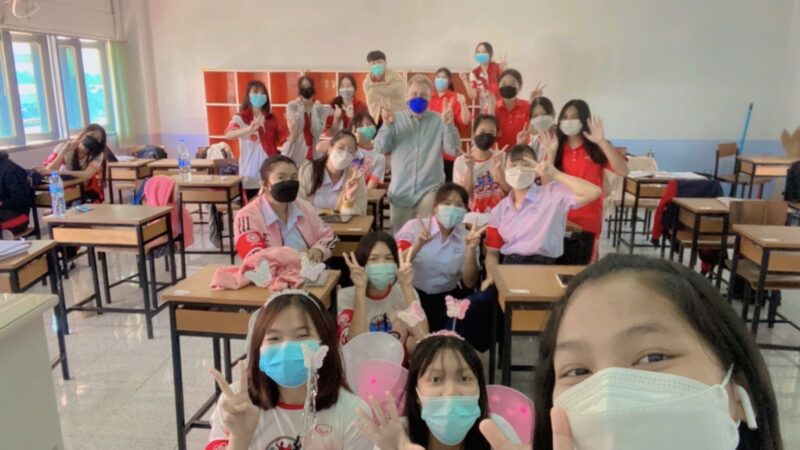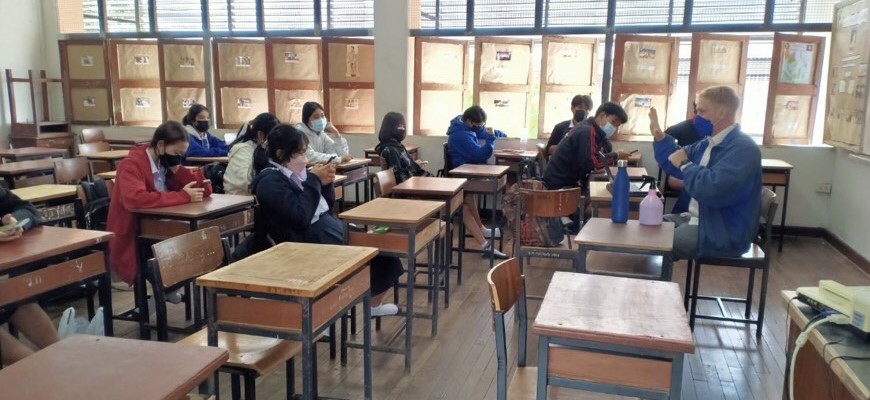By Josh Butterworth , Teacher in Phetchabun, Thailand
In this extended blog post, Josh shares his top teaching tips based on his time in Thailand so far. Catch up with part 1 here
Awkward pauses – One of the most difficult things that took me a few lessons to adjust to, was the long pauses that are inevitable when teaching awkward teenagers, who are often unconfident with their English ability, online. I’m afraid, you will almost certainly face this problem too. Sometimes it may feel like you have completely lost it, sitting at your laptop preaching to an audience of one, the gecko observing from the wall of your front room. But, take it from me, it really doesn’t matter. Don’t be afraid of the silences, don’t be embarrassed. Make a joke out of it and do whatever you can to encourage students to speak, but don’t beat yourself up if they don’t. Continue delivering your lesson with energy and pizazz, you cannot force students to participate, just make sure you are doing everything you can to give them to opportunity to do so.
Setting activities – Another time you may run into silence is during an activity. I wish I had discovered earlier the effectiveness of setting class activities for ten or fifteen minutes, and enjoying the peace and quiet of not hearing the sound of my own voice for a while. Whether it’s completing a worksheet or writing a few sentences, setting activities is a good way to consolidate content that you have been teaching. Do not be afraid to set the students work, tell them how long they have, turn off your camera and mic while they complete said activity, and enjoy their presentation of what they have produced. Granted, this can on occasion be absolutely nothing, but with your better classes you can expect interesting results, from which you can assess if your teaching has been successful, or not. Setting class work, and switching off for a while, can be daunting, but it is beneficial for the students and a deserved break for you.
Knowing names – Day one, as early as possible, get a register of all your classes from you co-teacher or teachers. It is impossible to learn all of your student’s names, I still only know a handful of mine, but I use them effectively. Try your best to remember the names of those students whose English ability is good and are willing to participate, you could potentially make notes on the register. Using these more able students will help you, especially in classes where students are less inclined to speak, if nobody answers then you can quash that awkward silence by calling on one of your top guns. If a student answers a question, ask them their name. Have short conversations when completing the register. Laugh at yourself when you make an absolute hash of their names and show them that pronunciation in a foreign language is hard, ask them how to say it properly, say it right, and prove that the only way you can improve is by speaking. Use the register as a random way of picking somebody to speak, make it fun. Who will be next? At the end of the day, students will appreciate you using their names as much as possible, it humanizes them and makes them feel important, as well as putting direct pressure on them and nobody else to speak.
Onsite teaching – My fingers and toes are crossed that when we start teaching at the beginning of term in May, we will be doing so in the classroom. Online teaching is a means to an end and the decision does not lie with us, it can be enjoyable and is a lot easier than onsite teaching in many ways, but real students in a real classroom is far better. So, keep everything crossed. I will now delve a bit into how to get the most from your onsite classes, some elements overlap with online teaching, but others are unique.
Games – Similarly to online teaching, there are many benefits to playing short warm up games at the beginning of your classes. It is also a lot easier to find in person ESL games on the internet, for all ages and abilities, so get Googling. In contrast to when you are online, games at the end of a lesson can also be a good way to consolidate content you have been teaching, and a way to reward students for good performance or behavior, a carrot if you will. I have not had much success playing games at the end of my online lessons. Students are very competitive (mostly) so you can really use this to your advantage when playing games in the classroom, as you can’t enforce participation online, this element does not work. I have three games for you to try below.
My name is & I like – This one is less of a game and more of a warmup activity, and it only works for your first lesson with a new class, but it’s an interesting way to get an idea of students speaking ability whilst learning information about them. This information can be used later use to create lesson content or spark up conversations. So, how it works is the first student will say, for example, “my name is Jack and I like tennis”. The next student will say “his name is Jack and he likes tennis, my name is Mary and I like K-Pop”, or whatever. The next will speak about Mary and then his or herself, and so on. Each student talking about the student before them and then themselves. This activity tests students listening and speaking ability, as well as their vocabulary knowledge. Almost all my classes enjoyed telling me something about themselves, especially in the better ability ones who will really try to impress you.
I bought – I’m sure you will have played this game at some point in your life. It’s essentially a memory game, but also tests students’ vocabulary knowledge, speaking and listening too. The version I played in years gone by starts with somebody saying “I went to the shop and bought a ___”, students struggle with the whole sentence so I advise sticking to “I bought a ___”. The first student will add one item, the next must say what the previous student said and add another, the third will say the first two items and add another, and so on, until students are having to remember ten, twenty or thirty items. Students love the challenge and its fun teasing them with where you start the line, it’s more difficult for the students at the end, of course. Some classes treat it almost as a team activity, helping each other out, which may be slightly bending the rules, but if they’re all speaking, it’s fine by me. And beware, I have had a few naughty items added to the list, usually I let it slide but it will be your call whether you do the same or not. It’s a fun game that students may pretend to hate but secretly love.

Categories/Last person standing – This game is a blast as it gets students up out and of their seats moving around, a novelty that they don’t get in their regular classes. The beauty of this game is that there is only one winner, out of the whole class, only one will be the last standing. It’s important to emphasize this, students get really excited at the prospect of winning gold, you could even have a prize, a bag of sweets or crisps. Not only does the possibility of winning themselves motivate students, but also their friends, when you get down to the last few students, they cheer each other on and its great fun. I suggest playing this at the end of class and using some lesson content as well as other topics. Right, everyone up and stand in a circle. The teacher will say a category, colors, animals, drinks or clothing for example. Working around the circle each student must say a word relating to whatever category, if they take too long, say a word that doesn’t fit the category or repeat a word that has already been said, then they must sit down and they are out. As the number of students left in the game gets smaller you can increase the difficulty of the categories, modes of transport, body parts, countries, fast food, musical instruments and so on. The key to playing this game successfully is the energy and enthusiasm that you bring as you stand in the center of the circle, joking with the students and making it fun but also competitive. When it gets down to the final two left in, get all the other students to sit down, clap and get involved as the two at the front of class battle it out, possibly even to the best of three, to make it even more spicy. I really hope you get the chance to enjoy this game as much as I have.
Presenting content – For one reason or another, I have not yet used a PPT in any of my onsite lessons in Thailand. I wouldn’t dream of going to an online class without the safety of one, but so far, onsite, my trusty board pens and lots of energy have done me solid. I assume that you, like all the foreign teachers at my school, will be given a textbook full of content to teach. It is completely up to you whether you deliver that content using PPTs or not, honestly, it’s just best to go with whatever you feel most comfortable with. But personally, I prefer to go to class with a plan, pens and plenty of activities and games, in which I can use content from the textbook to consolidate learning. If I am teaching key vocabulary for instance, I will write them on the board and run through them with students repeating after me, using different intonation, speed and volume, students usually enjoy this, and you can have some fun with it. I would find it more difficult to do this using a PPT, having to be close to the computer changing slides and of course there is the possibility that technology may fail you, and then you end up wasting time trying to make it work. So, I prefer the flexibility and freedom of teaching without tech, onsite, but try both and see what works for you.
Activities – Setting your onsite students an activity, a worksheet or getting them to write a few sentences, just as it is online, can be an effective way to give yourself (and your students) a break from the sound of your voice. Silence in the classroom, or mild chatter, can be daunting, but don’t let this deter you. Students must complete activities to prove they are confident with what they have been learning. As students complete the task you can walk around the classroom and offer help to anyone that needs it, unlike online, you can make sure everybody is on the right track and has the best chance to produce something. Also, onsite activities are great because you can pick anyone to present their work upon completion, this is difficult and sometimes impossible online as you cannot do anything about those students who are unwilling to speak.
Getting everyone involved (ball-you speak) – The best thing about onsite teaching is obvious, you are in the same room as your students. This fact means you can get everyone involved, everyone, unlike online, where maybe, if you’re lucky, 25% of your students will participate in any one class. It is important you take advantage of this and make sure all your students are learning. It is a lot easier to learn students’ names onsite than it is online, but you won’t have the luxury of being able to look at the notes you have made on the register, I encourage you to request students say their name every time they answer a question or speak, like I mentioned earlier, this will help them feel known and encourage them to participate. Another great trick, which I find quite effective, is using a ball or something else you can throw around the classroom without causing severe injury. Whoever you throw the ball will answer a question or create a sentence using some key vocabulary, for example. But make sure you get students to say their names first. And, if they are up for it, students can throw the ball to each other, encouraging them to speak with the reward of power to decide who will be next.
Conclusion – Look, I am far from a teaching expert, but I have found a few ways to make my online and onsite classrooms work, for me, and more importantly, for my students. The best piece of advice I can give to a new teacher is telling them not to worry, be confident, energetic and don’t expect to be perfect, because nobody else is expecting you to be. The Thai teachers are not perfect, and all they want to see from you is commitment, passion for your students and a willingness to help them succeed. You will learn as you go along and it is crucial that you are not afraid to ask questions, if the first person cannot answer then the next will. We cannot predict what will happen with COVID, nor do we have any sway over whether we are online or onsite, it’s important you are flexible and know that you can have successful classes with both ways, just be prepared, don’t worry. There is a very famous and important Thai saying, “Mai Pen Rai”, it means it’s ok and don’t worry. This is an attitude I think we could learn a lot from in the West. Embrace it, don’t worry, it’s ok, it’s going to be ok and you are going to be great. I really hope this blog has helped you and if you are feeling even an inch more confident about your teaching, then I have done my job.
Thanks for reading, all the best, Josh!
Would you like to teach English in Thailand? Explore our program page or submit an application




